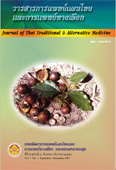The Problem of Pain in Complementary and Alternative Medicine
Main Article Content
Abstract
Pain is the most common problem encountered in clinical practice. Pain, particularly chronic pain and that experienced by cancer patients, is the most common group using complementary and alternative medicine (CAM). Most CAM is not evidence-based; instead, it is experience-based. Surprisingly more and more Americans are turning to complementary and alternative medicine to help manage and treat their pain. Also, many medical schools in North America include the study of CAM in modern medicine as integrative medicine. In this context, it is necessary for us to understand the general concept of CAM (holistic), and classification (alternative medicine system, mind-body intervention, biologically based therapy, manipulative and bodybased therapy, and energy therapy). In predicting the benefits to be derived from CAM and the safety of CAM, it is based on many things, for example the beliefs of the patient, the skill of the therapist, which dimension of holistic (body, mind, social, or spiritual) that CAM can help, contraindications and precautions, and cost. The mix and match with integrative medicine is individual-to-individual depending on each patient. It is fundamental to assess the individual and holistic profile of each patient.
Article Details
References
2. Eisenberg DM, Davis RB, Ettner SL, Appel S, Willkey S, Van Rompay M, et al. Trends in alternative medicine use in the United States. JAMA 1998;280:1569-75.
3. Gordon NP, Sobel DS, Tarazona EZ, Use of and interest in alternative therapies among adult primary care clinicians and adults members in a large health maintenance organization. West J Med 1998;169:153-61.
4. Foundation for the Advancement of Innovative Medicine [homepage on the internet]. New York. CAM facts;c1999 [updated 2000 July 9]. Available from: http://www.faim.org/fact.htm
5. Eisenberg DM. Advising patients who seek alternative medical therapies. Ann Intern Med 1997;127:61-68.
6. Wetzel MS, Eisenberg DM, Kaptchuk TJ. Courses involving complementary and alternative medicine at U.S. medical schools. JAMA 1998;280:784-7.
7. Shiflett SC. Overview of complementary therapies in physical medicine and rehabilitation. Phy Med Rehabil Clin N Am 1999;10:521-9.
8. Bliddal H, Rosetzsky A, Schlichting P, Weidner MS, Andersen LA, Ibfelt HH, et al. A randomized, placebo-controlled, cross-over study of ginger extracts and ibuprofen in osteoarthritis. Osteoarthritis Cartilage 2000;8:9-12.


